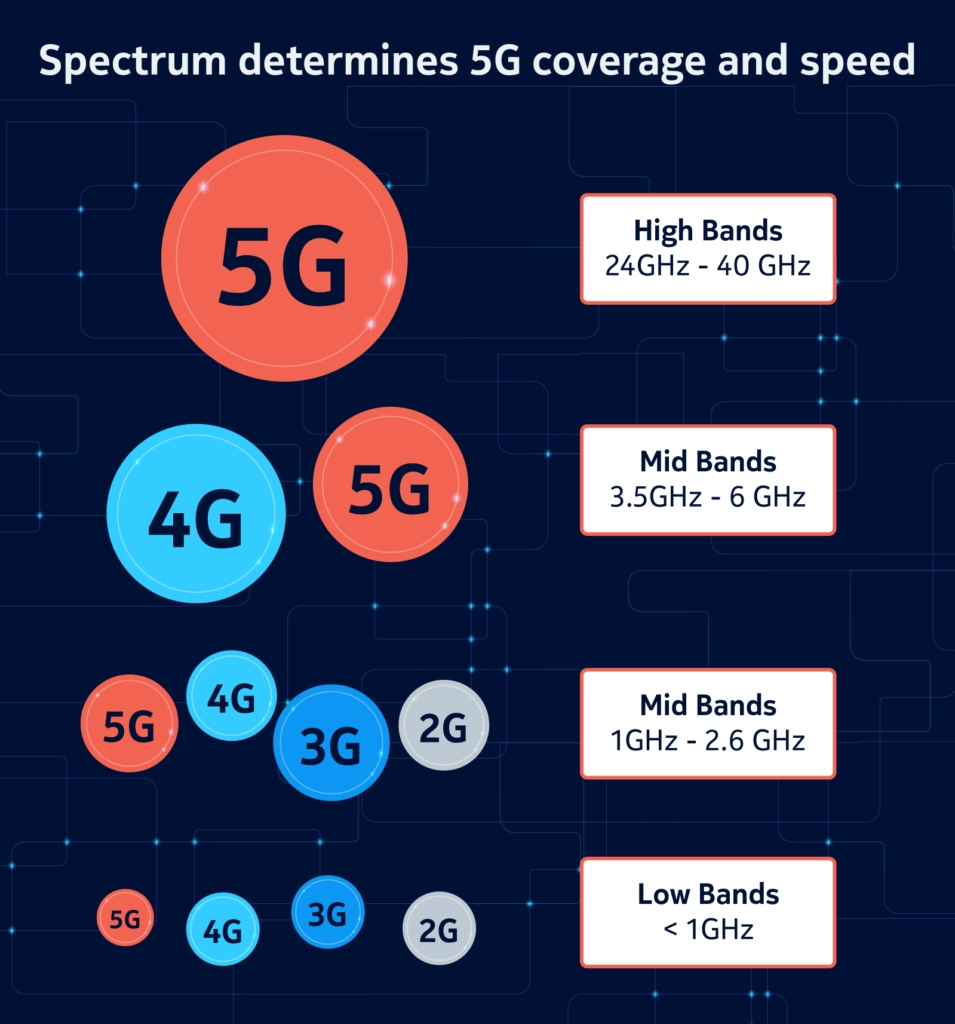5G presents some new challenges for wireless operators. On one hand, 5G networks are intended to support faster mobile broadband speeds and lower latencies making new applications possible like on-demand video and autonomous vehicles. On the other hand, 5G will require wireless operators to have access to large amounts of spectrum to make these new services a reality.
The GSMA, a global trade organization that represents mobile operators, recommends that regulators and government agencies that control 5G spectrum allocation make 80-100 MHz of contiguous spectrum available per operator in prime 5G bands and about 1 GHz of spectrum per operator available in millimeter wave bands.

1.5G low-band spectrum offers blanket coverage
Low-band spectrum is any spectrum that is lower than 1 GHz on the spectrum chart. Early wireless networks, often referred to as analog cellular, were deployed in low-band 800 MHz spectrum.
At the time operators often referred to low-band spectrum as “beachfront property” because it was so desirable. Wireless carriers could serve thousands of customers within hundreds of square miles with just one tower.
In a 5G world, low-band spectrum will make it possible for operators to provide a wide swath of coverage but it also means that the speed and latency of the 5G network will probably only be incrementally better than what is delivered with 4G networks. Much of the 5G network’s performance will depend upon your proximity to the cell site. However, low-band spectrum does make it easier for the wireless signal to penetrate windows and walls.
2.5G mid-band spectrum provides coverage and capacity
Spectrum in the 1 GHz – 6 GHz frequencies is mid-band spectrum and it is considered ideal for 5G because it can carry plenty of data while also traveling significant distances. The GSMA describes spectrum in the 3.3 GHz to 3.8 GHz range as particularly appealing. The organization explained in a recent white paper that this spectrum is ideal because many countries around the world have already designated it for 5G.
However, other mid-band spectrum is also being used for 5G. For example, operators in China and Japan are planning to use 4.5 GHz -5 GHz spectrum for 5G. And some operators in U.S. and Canada are planning to use (or are already using) the 2.3 GHz and the 2.5 GHz-2.6 GHz spectrum for 5G.
3.5G high-band spectrum delivers super-fast speeds over short distances
The third bucket of spectrum where wireless operators are deploying 5G is in the millimeter wave spectrum. This is very high on the spectrum chart in the 24 GHz band and higher. The GSMA recommends that operators support millimeter wave spectrum in the 26 GHz, 40 GHz, 50 GHz and 66 GHz frequency bands for mobile services.
Millimeter wave spectrum is limited because signals can’t travel very far — in some cases the signal will travel less than a mile — and they are also susceptible to interference from things like trees and buildings and even glass.
But the benefit of millimeter wave spectrum is that if the signal is unencumbered users can get connection speeds between 1 Gbps to 3 Gbps or even higher.
4.Spectrum determines 5G speed and coverage
Spectrum will play a key role in the type of 5G service that operators will be able to provide to their customers. High-band spectrum may give you blazing fast speeds and lots of capacity —but only if you are close to the cell site. Low-band may provide excellent coverage but the network performance may only be a small step up from 4G.
One thing you can count on in the coming years is that operators will continue to fine-tune their 5G networks by expanding existing coverage, making additional spectrum purchases, and taking advantage of new technologies.
Buy the way, you can check the price of 5G devices.
Learn More:
Huawei Nova 7 SE 5G Vs. Huawei Nova 7 5G Vs. Huawei Nova 7 Pro 5G



















































































































